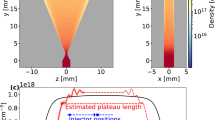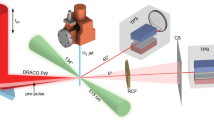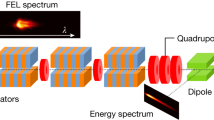Abstract
Table-top laser-driven plasma accelerators are gaining attention for their potential use in miniaturizing future high-energy accelerators. By irradiating gas jet targets with ultrashort intense laser pulses, the generation of quasimonoenergetic electron beams was recently observed. Currently, the stability of beam generation and the ability to scale to higher electron beam energies are critical issues for practical laser acceleration. Here, we demonstrate the first generation of stable GeV-class electron beams from stable few-millimetre-long plasma channels in a self-guided wakefield acceleration process. As primary evidence of the laser wakefield acceleration in a bubble regime, we observed a boost of both the electron beam energy and quality by reducing the plasma density and increasing the plasma length in a 1-cm-long gas jet. Subsequent three-dimensional simulations show the possibility of achieving even higher electron beam energies by minimizing plasma bubble elongation, and we anticipate dramatic increases in beam energy and quality in the near future. This will pave the way towards ultracompact, all-optical electron beam accelerators and their applications in science, technology and medicine.
This is a preview of subscription content, access via your institution
Access options
Subscribe to this journal
Receive 12 print issues and online access
$209.00 per year
only $17.42 per issue
Buy this article
- Purchase on Springer Link
- Instant access to full article PDF
Prices may be subject to local taxes which are calculated during checkout





Similar content being viewed by others
References
Perry, M. D. & Mourou, G. Terawatt to petawatt subpicosecond lasers. Science 264, 917–924 (1994).
Mourou, G., Tajima, T. & Bulanov, S. V. Optics in the relativistic regime. Rev. Mod. Phys. 78, 309–371 (2006).
Tajima, T. & Dawson, J. M. Laser electron accelerator. Phys. Rev. Lett. 43, 267–270 (1979).
Thomas, A. G. R. et al. Effect of laser-focusing conditions on propagation and monoenergetic electron production in laser-wakefield accelerators. Phys. Rev. Lett. 98, 095004 (2007).
Faure, J. et al. A laser–plasma accelerator producing monoenergetic electron beams. Nature 431, 541–544 (2004).
Mangles, S. P. D. et al. Monoenergetic beams of relativistic electrons from intense laser–plasma interactions. Nature 431, 535–538 (2004).
Geddes, C. G. R. et al. High-quality electron beams from a laser wakefield accelerator using plasma-channel guiding. Nature 431, 538–541 (2004).
Pukhov, A. & Meyer-ter-Vehn, J. Laser wakefield acceleration: the highly non-linear broken-wave regime. Appl. Phys. B. Lasers Opt. 74, 355–361 (2002).
Patel, N. The plasma revolution. Nature 449, 133–135 (2007).
Hidding, B. et al. Generation of quasimonoenergetic electron bunches with 80 fs laser pulses. Phys. Rev. Lett. 96, 105004 (2006).
Leemans, W. P. et al. GeV electron beams from a centimetre-scale accelerator. Nature Phys. 2, 696–699 (2006).
Karsch, S. et al. GeV-scale electron acceleration in a gas-filled capillary discharge waveguide. New J. Phys. 9, 415 (2007).
Tsung, F. S. et al. Simulation of monoenergetic electron generation via laser wakefield accelerators for 5–25 TW lasers. Phys. Plasmas 13, 056708 (2006).
Maksimchuk, A. et al. Energy scaling of quasi-monoenergetic electron beams from laser wakefields driven by 40 TW ultra-short pulses. Appl. Phys. B. 89, 201–207 (2007).
Lu, W. et al. Generating multi-GeV electron bunches using single stage laser wakefield acceleration in a 3D nonlinear regime. Phys. Rev. ST-AB 10, 061301 (2007).
Hafz, N. M. et al. Dependence of the electron beam parameters on the stability of laser propagation in a laser wakefield accelerator. Appl. Phys. Lett. 90, 151501 (2007).
Faure, J. et al. Controlled injection and acceleration of electrons in plasma wakefields by colliding laser pulses. Nature 444, 737–739 (2006).
Umstadter, D., Kim, J.-K. & Dodd, E. Laser injection of ultrashort electron pulses into wakefield plasma waves. Phys. Rev. Lett. 76, 2073–2076 (1996).
Esarey, E. et al. Electron injection into plasma wakefields by colliding laser pulses. Phys. Rev. Lett. 79, 2682–2685 (1997).
Hur, M. S., Gupta, D. N. & Suk, H. Enhanced electron trapping by a static longitudinal magnetic field in laser wakefield acceleration. Phys. Lett. A 372, 2684–2687 (2008).
Nieter, C. & Cary, J. R. VORPAL: a versatile plasma simulation code. J. Comput. Phys. 196, 448–473 (2004).
Jeong, T. M. et al. Wavefront correction and customization of focal spot of 100 TW Ti:sapphire laser system. Jpn J. Appl. Phys. 46, 7724–7730 (2007).
Hosokai, T. et al. Supersonic gas jet target for generation of relativistic electrons with 12 TW-50 fs laser pulse. Proc. EPAC 2002, 981–983 (2002).
Hosokai, T. et al. Effect of a laser prepulse on a narrow-cone ejection of MeV electrons from a gas jet irradiated by an ultrashort laser pulse. Phys. Rev. E 67, 036407 (2003).
Kando, M. et al. Electron acceleration by a nonlinear wakefield generated by ultrashort (23 fs) high-peak-power laser pulses in plasma. Phys. Rev. E 71, 015403 (R) (2005).
Hosokai, T. et al. Effect of external static magnetic field on the emittance and total charge of electron beams generated by laser-wakefield acceleration. Phys. Rev. Lett. 97, 075004 (2006).
Glinec, Y. et al. Absolute calibration for a broad range single shot electron spectrometer. Rev. Sci. Instrum. 77, 103301 (2006).
Acknowledgements
We thank S.W. Kang for his technical support during the experiment. We acknowledge useful discussions with H.T. Kim, Y.C. Noh, H. Kotaki, M. Uesaka, K. Nakajima and T. Tajima. This work was supported by the Ministry of Knowledge and Economy of Korea through the Ultrashort Quantum Beam Facility Program.
Author information
Authors and Affiliations
Corresponding author
Supplementary information
Supplementary Information
Stable generation of GeV–class electron beam from self–guided laser–plasma channels (PDF 3264 kb)
Rights and permissions
About this article
Cite this article
Hafz, N., Jeong, T., Choi, I. et al. Stable generation of GeV-class electron beams from self-guided laser–plasma channels. Nature Photon 2, 571–577 (2008). https://doi.org/10.1038/nphoton.2008.155
Received:
Accepted:
Published:
Issue Date:
DOI: https://doi.org/10.1038/nphoton.2008.155
This article is cited by
-
Efficient plasma electron accelerator driven by linearly chirped multi-10-TW laser pulses
Scientific Reports (2023)
-
Direct observation of relativistic broken plasma waves
Nature Physics (2022)
-
Cascaded high-gradient terahertz-driven acceleration of relativistic electron beams
Nature Photonics (2021)
-
Optimization of laser-based synchrotron X-ray for plant imaging
Applied Physics B (2019)
-
Towards high-energy, high-resolution computed tomography via a laser driven micro-spot gamma-ray source
Scientific Reports (2018)



